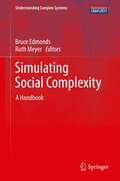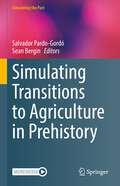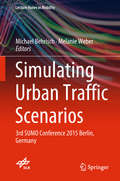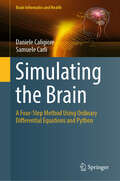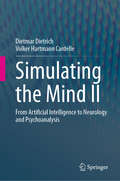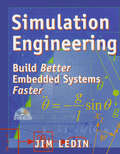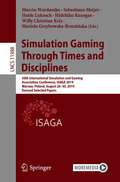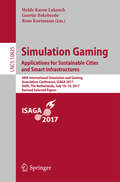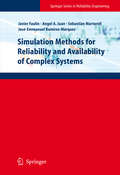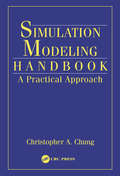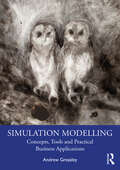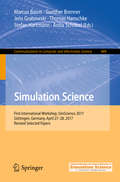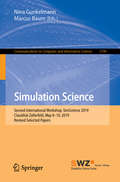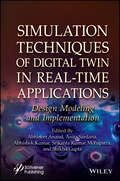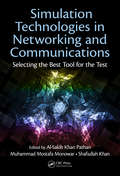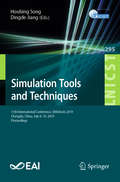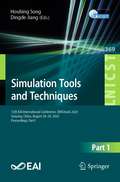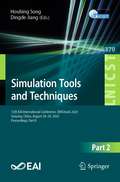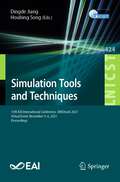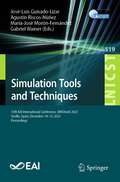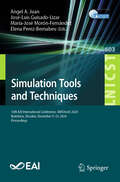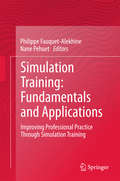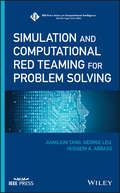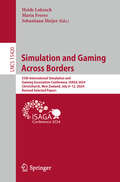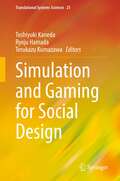- Table View
- List View
Simulating Social Complexity
by Bruce Edmonds Ruth MeyerSocial systems are among the most complex known. This poses particular problems for those who wish to understand them. The complexity often makes analytic approaches infeasible and natural language approaches inadequate for relating intricate cause and effect. However, individual- and agent-based computational approaches hold out the possibility of new and deeper understanding of such systems. Simulating Social Complexity examines all aspects of using agent- or individual-based simulation. This approach represents systems as individual elements having each their own set of differing states and internal processes. The interactions between elements in the simulation represent interactions in the target systems. What makes these elements "social" is that they are usefully interpretable as interacting elements of an observed society. In this, the focus is on human society, but can be extended to include social animals or artificial agents where such work enhances our understanding of human society. The phenomena of interest then result (emerge) from the dynamics of the interaction of social actors in an essential way and are usually not easily simplifiable by, for example, considering only representative actors. The introduction of accessible agent-based modelling allows the representation of social complexity in a more natural and direct manner than previous techniques. In particular, it is no longer necessary to distort a model with the introduction of overly strong assumptions simply in order to obtain analytic tractability. This makes agent-based modelling relatively accessible to a range of scientists. The outcomes of such models can be displayed and animated in ways that also make them more interpretable by experts and stakeholders. This handbook is intended to help in the process of maturation of this new field. It brings together, through the collaborative effort of many leading researchers, summaries of the best thinking and practice in this area and constitutes a reference point for standards against which future methodological advances are judged. This book will help those entering into the field to avoid "reinventing the wheel" each time, but it will also help those already in the field by providing accessible overviews of current thought. The material is divided into four sections: Introductory, Methodology, Mechanisms, and Applications. Each chapter starts with a very brief section called 'Why read this chapter?' followed by an abstract, which summarizes the content of the chapter. Each chapter also ends with a section of 'Further Reading' briefly describing three to eight items that a newcomer might read next.
Simulating Transitions to Agriculture in Prehistory (Computational Social Sciences)
by Salvador Pardo-Gordó Sean BerginThis book highlights new and innovative approaches to archaeological research using computational modeling while focusing on the Neolithic transition around the world.The transformative effect of the spread and adoption of agriculture in prehistory cannot be overstated. Consequently, archaeologists have often focused their research on this transition, hoping to understand both the ecological causes and impacts of this shift, as well as the social motivations and constraints involved. Given the complex interplay of socio-ecological factors, the answers to these types of questions cannot be found using traditional archaeological methods alone. Computational modeling techniques have emerged as an effective approach for better understanding prehistoric data sets and the linkages between social and ecological factors at play during periods of subsistence change. Such techniques include agent-based modeling, Bayesian modeling, GIS modeling of the prehistoric environment, and the modeling of small-scale agriculture. As more archaeological data sets aggregate regarding the transition to agriculture, researchers are often left with few ways to relate these sets to one another.Computational modeling techniques such as those described above represent a critical next step in providing archaeological analyses that are important for understanding human prehistory around the world. Given its scope, this book will appeal to the many interdisciplinary scientists and researchers whose work involves archaeology and computational social science.
Simulating Urban Traffic Scenarios: 3rd SUMO Conference 2015 Berlin, Germany (Lecture Notes in Mobility)
by Michael Behrisch Melanie WeberThis contributed volume contains the conference proceedings of the Simulation of Urban Mobility (SUMO) conference 2015, Berlin. The included papers cover a wide range of topics in traffic planning and simulation, including intermodal simulation, intermodal transport, vehicular communication, modeling urban mobility, open data as well as autonomous driving. The target audience primarily comprises researchers and experts in the field of mobility research, but the book may also be beneficial for graduate students.
Simulating the Brain: A Four-Step Method Using Ordinary Differential Equations and Python (Brain Informatics and Health)
by Daniele Caligiore Samuele CarliThis book presents a new methodology to develop system-level brain models using ordinary differential equations (ODE), which are to be solved and analyzed through simple Python scripts. Computer simulations of this kind of models allow the study of healthy and damaged brain functions, the discovery of new neural pathways that may be crucial for the emergence of pathologies, and to simulate the effects of possible new therapies acting on brain actors which are difficult to investigate in traditional research.The methodology consists of four steps: (i) design the model architecture which represents the interactions between different brain areas; (ii) write the ODE system which are implied by the model; (iii) build a Python script that correctly solves the equations; (iv) optimize the free model parameters using genetic algorithms or other techniques to obtain one or more model instances that reproduce the target investigated behavior.This book is for all people who want to learn how to use Python and ODE to simulate brain functions regardless of their backgrounds. While rigorous mathematical proofs of many aspects of the arguments discussed are out of the scope of this work and are therefore omitted, the most important concepts necessary for the critical judgment and self-assessment of the practitioner’s work are exposed in a simplified, readily applicable form, with extensive references for the adventurous reader to explore. The book is a self-consistent textbook containing all pieces necessary to learn from scratch: from the essential mathematical and computing tools to the knowledge necessary to design, simulate, visualize, and interpret brain models. These skills are acquired through several hands-on examples explained step-by-step. One important and distinctive aspect of the book is that, beside the theory, it provides the necessary contexts and practical examples which are key to the correct application of the proposed methodology.
Simulating the Mind II: From Artificial Intelligence to Neurology and Psychoanalysis
by Dietmar Dietrich Volker Hartmann CardelleThe declared goal of this book, an extended and revised translation of the German edition (2021), is to show how a unified model of the psyche and body can be developed via insights from psychoanalysis, neurology and computer technology. On the one hand, such a model allows for the testing of psychological and social theories on a scientific basis with the help of simulation experiments. On the other hand, the model developed according to the functional structures of the human brain and psyche provides the basis for artificial intelligence systems. These are systems with cognitive capabilities that can save human lives, save energy, ensure safety at airports, provide support in old-age care and in the medical field; in other words and generally speaking, systems that can simplify our lives in a relevant way and on a broad basis. A great deal of time and money is invested in genetic engineering and neurology, but research into the mental apparatus in the context of the neurological part, i.e., modeling the brain in a holistic way, is sparse in every respect. However, the results of the scientific project SiMA, of which the first author has been a driving force, show that the research of this organ, which in the authors’ understanding includes the mental apparatus, as a whole, is quite feasible today. This is also the main message of the book, which addresses topics such as artificial intelligence, the brain, psychoanalysis, behavioral models, complexity, bionics of the mental, emotions and feelings, consciousness and awareness, preconscious and unconscious, the functional (and not only behavioral) description and modeling of the brain and especially of the mental apparatus, and some more. In the world of technology, there is generally little interest in psychoanalysis, whereas in the world of psychoanalysis, people usually refuse to deal with mathematics and technology, especially computer technology. Is there an information theory of the brain on the one hand, and of computer technology on the other hand? The authors attempt to answer this question from both sides. With the goal to reach as many readers as possible and to provoke, the authors break with traditions and give space to new forms of thinking and argue that it is crucial to take a new path in automation, in artificial intelligence and in (technical) cognitive science, but also in psychoanalysis and neurology, in order to create a common basis for scientific and technical possibilities that have been previously inaccessible.
Simulation Engineering: Build Better Embedded Systems Faster
by Jim LedinBuild complex embedded systems faster and with lower costs by: * Knowing when and how much simulation testing is appropriate * Applying engineering methods to simulation design and development * Using the best tools available to develop simulations. * Va
Simulation Gaming Through Times and Disciplines: 50th International Simulation and Gaming Association Conference, ISAGA 2019, Warsaw, Poland, August 26–30, 2019, Revised Selected Papers (Lecture Notes in Computer Science #11988)
by Hidehiko Kanegae Marcin Wardaszko Sebastiaan Meijer Heide Lukosch Willy Christian Kriz Mariola Grzybowska-BrzezińskaThis book constitutes revised selected papers from the 50th International Simulation and Gaming Association Conference, ISAGA 2019, which took place in Warsaw, Poland, during August 26–30, 2019.The 38 papers presented in this volume were carefully reviewed and selected from 72 submissions. They were organized in topical sections named: simulation gaming in the science space; simulation gaming design and implementation; simulation games for current challenges; simulation games and gamification; and board perspective on simulation gaming.
Simulation Gaming. Applications for Sustainable Cities and Smart Infrastructures: 48th International Simulation And Gaming Association Conference, Isaga 2017, Delft, The Netherlands, July 10-14, 2017, Revised Selected Papers (Theoretical Computer Science and General Issues #10825)
by Heide Karen Lukosch Geertje Bekebrede Rens KortmannThis book constitutes the refereed post-conference proceedings of the 48th International Simulation and Gaming Association Conference, ISAGA 2018, held in Delft, The Netherlands, in July 2018. The 19 revised full papers included in the volume were carefully reviewed and selected from 27 submissions. The contributions to this book range from design thinking related to simulation gaming, the analysis of the consequences of design choices in games, to games for decision making, examples of games for business, climate change, maritime spatial planning, sustainable city development, supply chain, and much more.
Simulation Methods for Reliability and Availability of Complex Systems
by Jose Emmanuel Ramirez-Marquez Sebastián Salvador Martorell Alsina Javier Faulin Angel A. JuanSimulation Methods for Reliability and Availability of Complex Systems discusses the use of computer simulation-based techniques and algorithms to determine reliability and availability (R and A) levels in complex systems. The book: shares theoretical or applied models and decision support systems that make use of simulation to estimate and to improve system R and A levels, forecasts emerging technologies and trends in the use of computer simulation for R and A and proposes hybrid approaches to the development of efficient methodologies designed to solve R and A-related problems in real-life systems. Dealing with practical issues, Simulation Methods for Reliability and Availability of Complex Systems is designed to support managers and system engineers in the improvement of R and A, as well as providing a thorough exploration of the techniques and algorithms available for researchers, and for advanced undergraduate and postgraduate students.
Simulation Modeling Handbook: A Practical Approach
by Christopher A. ChungThe use of simulation modeling and analysis is becoming increasingly more popular as a technique for improving or investigating process performance. This book is a practical, easy-to-follow reference that offers up-to-date information and step-by-step procedures for conducting simulation studies. It provides sample simulation project support materi
Simulation Modelling: Concepts, Tools and Practical Business Applications
by Andrew GreasleyWhile simulation has a vast area of application, this textbook focuses on the use of simulation to analyse business processes. It provides an up-to-date coverage of all stages of the discrete-event simulation (DES) process, covering important areas such as conceptual modelling, modelling input data, verification and validation and simulation output analysis. The book is comprehensive yet uncomplicated, covering the theoretical aspects of the subject and the practical elements of a typical simulation project, demonstrated by cases, examples and exercises. It also shows how simulation relates to new developments in machine learning, big data analytics and conceptual modelling techniques. Guidance is provided on how to build DES models using the Arena, Simio and Simul8 simulation software, and tutorials for using the software are incorporated throughout. Simulation Modelling offers a uniquely practical and end-to-end overview of the subject, which makes it perfect required or recommended reading for advanced undergraduate and postgraduate students studying business simulation and simulation modelling as part of operations research, business analytics, supply chain management and computer science courses.
Simulation Science: First International Workshop, Simscience 2017, Göttingen, Germany, April 27-28, 2017, Revised Selected Papers (Communications In Computer And Information Science #889)
by Stefan Hartmann Anita Schöbel Jens Grabowski Marcus Baum Gunther Brenner Thomas HanschkeThis book constitutes the thoroughly refereed proceedings of the Clausthal-Göttingen International Workshop on Simulation Science, held in Göttingen, Germany, in April 2017. The 16 full papers presented were carefully reviewed and selected from 40 submissions. The papers are organized in topical sections on simulation and optimization in networks, simulation of materials, distributed simulations.
Simulation Science: Second International Workshop, SimScience 2019, Clausthal-Zellerfeld, May 8-10, 2019, Revised Selected Papers (Communications in Computer and Information Science #1199)
by Marcus Baum Nina GunkelmannThis book constitutes the refereed proceedings of the Second International Workshop on Simulation Science, held in Clausthal-Zellerfeld, in May 2019. The 12 full papers were carefully reviewed and selected from 47 submissions. The papers are organized according to the following topics: optimization and distributed simulations; simulation of materials; self-organized and porous structures; simulation of materials: finite element and multiscale methods.
Simulation Techniques of Digital Twin in Real-Time Applications: Design Modeling and Implementation
by Abhishek Kumar Shikha Gupta Abhineet Anand Anita Sardana Srikanta Kumar MohapatraSIMULATION TECHNIQUES OF DIGITAL TWIN IN REAL-TIME APPLICATIONS The book gives a complete overview of implementing digital twin technology in real-time scenarios while emphasizing how this technology can be embedded with running technologies to solve all other issues. Divided into two parts with Part 1 focusing on simulated techniques in digital twin technology and Part 2 on real-time applications of digital twin technology, the book collects a significant number of important research articles from domain-specific experts. The book sheds light on the various techniques of digital twin technology that are implemented in various application areas. It emphasizes error findings and respective solutions before the actual event happens. Most of the features in the book are on the implementation of strategies in real-time applications. Various real-life experiences are taken to show the proper implementation of simulation technologies. The book shows how engineers of any technology can input their research ideas to convert to real scenarios by using replicas. Hence, the book has a collection of research articles from various engineers with expertise in different technologies from many regions of the world. It shows how to implement the embedded real-time data into technologies. Specifically, the chapters relate to the auto landing and cruising features in aerial vehicles, automated coal mining simulation strategy, the enhancement of workshop equipment, and implementation in power energy management for urban railways. This book also describes the coherent mechanism of digital twin technologies with deep neural networks and artificial intelligence. Audience Researchers, engineers, and students in computer science, software engineering and industrial engineering, will find this book to be very useful.
Simulation Technologies in Networking and Communications: Selecting the Best Tool for the Test
by Al-Sakib Khan Pathan Muhammad Mostafa Monowar Shafiullah KhanSimulation is a widely used mechanism for validating the theoretical model of networking or communication systems. Although the claims made based on simulations are considered to be reliable, how reliable they really are is best determined with real-world implementation trials. This book addresses various issues covering different mechanisms related to simulation technologies in networking and communications fields. Focusing on the practice of simulation testing instead of the theory, it reviews and evaluates popular simulation modeling tools and recommends the best tools for specific tests.
Simulation Tools and Techniques: 11th International Conference, SIMUtools 2019, Chengdu, China, July 8–10, 2019, Proceedings (Lecture Notes of the Institute for Computer Sciences, Social Informatics and Telecommunications Engineering #295)
by Houbing Song Dingde JiangThis volume constitutes the refereed post-conference proceedings of the 11th International Conference on Simulation Tools and Techniques, SIMUTools 2019, held in Chengdu, China, in August 2019. The 97 revised full papers were carefully selected from 156 submissions. The papers focus on simulation methods, simulation techniques, simulation software, simulation performance, modeling formalisms, simulation verification and widely used frameworks.
Simulation Tools and Techniques: 12th EAI International Conference, SIMUtools 2020, Guiyang, China, August 28-29, 2020, Proceedings, Part I (Lecture Notes of the Institute for Computer Sciences, Social Informatics and Telecommunications Engineering #369)
by Houbing Song Dingde JiangThis two-volume set constitutes the refereed post-conference proceedings of the 12th International Conference on Simulation Tools and Techniques, SIMUTools 2020, held in Guiyang, China, in August 2020. Due to COVID-19 pandemic the conference was held virtually. The 125 revised full papers were carefully selected from 354 submissions. The papers focus on simulation methods, simulation techniques, simulation software, simulation performance, modeling formalisms, simulation verification and widely used frameworks.
Simulation Tools and Techniques: 12th EAI International Conference, SIMUtools 2020, Guiyang, China, August 28-29, 2020, Proceedings, Part II (Lecture Notes of the Institute for Computer Sciences, Social Informatics and Telecommunications Engineering #370)
by Houbing Song Dingde JiangThis two-volume set constitutes the refereed post-conference proceedings of the 12th International Conference on Simulation Tools and Techniques, SIMUTools 2020, held in Guiyang, China, in August 2020. Due to COVID-19 pandemic the conference was held virtually. The 125 revised full papers were carefully selected from 354 submissions. The papers focus on simulation methods, simulation techniques, simulation software, simulation performance, modeling formalisms, simulation verification and widely used frameworks.
Simulation Tools and Techniques: 13th EAI International Conference, SIMUtools 2021, Virtual Event, November 5-6, 2021, Proceedings (Lecture Notes of the Institute for Computer Sciences, Social Informatics and Telecommunications Engineering #424)
by Houbing Song Dingde JiangThis proceedings constitutes the refereed post-conference proceedings of the 13th International Conference on Simulation Tools and Techniques, SIMUTools 2021, held in November 2021. Due to COVID-19 pandemic the conference was held virtually. The 63 revised full papers were carefully selected from 143 submissions. The papers focus on new results in the field of system modeling and simulation, software simulation, communication networks’ modeling and analysis, AI system simulation and performance analysis, big data simulation analysis, addressing current and future trends in simulation techniques. They are grouped in thematic aspects on wireless communication, big data, modeling and simulation, deep learning, network simulation and life and medical sciences.
Simulation Tools and Techniques: 15th EAI International Conference, SIMUtools 2023, Seville, Spain, December 14-15, 2023, Proceedings (Lecture Notes of the Institute for Computer Sciences, Social Informatics and Telecommunications Engineering #519)
by Agustín Riscos-Núñez José-Luis Guisado-Lizar María-José Morón-Fernández Gabriel WainerThis proceedings constitutes the refereed post-conference proceedings of the 15th International Conference on Simulation Tools and Techniques, SIMUTools 2023, held in Seville, Spain, in December 2023. The 23 revised full papers were carefully selected from 58 submissions. The papers focus on various areas such as Simulation Tools and Methods; Artificial Intelligence and Simulation; Transportation and Logistics; Medical Sciences; and Network Simulations.
Simulation Tools and Techniques: 16th EAI International Conference, SIMUtools 2024, Bratislava, Slovakia, December 9–10, 2024, Proceedings (Lecture Notes of the Institute for Computer Sciences, Social Informatics and Telecommunications Engineering #603)
by Angel A. Juan José-Luis Guisado-Lizar María-José Morón-Fernández Elena Perez-BernabeuThis book constitutes the refereed post-conference proceedings of the 16th EAI International Conference on Simulation Tools and Techniques, SIMUTools 2024, held in Bratislava, Slovakia, in December 2024. The 26 full papers included in this book were carefully reviewed and selected from 63 submissions. They were organized in topical sections as follows: simulation tools and methods, traffic simulations, logistics and manufacturing, robotics simulations, applications of simulations, and network simulations.
Simulation Training: Fundamentals and Applications
by Philippe Fauquet-Alekhine Nane PehuetDrawing on decades of industrial experience, this insightful and practical guide uses case studies and an interdisciplinary perspective to explain the fundamentals of simulation training to improve performance of high-risk professional activities. It seeks to identify those conditions under which simulation training has been shown to improve professional practice while employing extensive real examples. Simulation Training: Fundamentals and Application helps readers to develop their own synthesis of the simulation learning method and to use such training to enhance their skills and performance. Case studies demonstrate five specific theatres of professional practice - the nuclear-power industry, aeronautics, surgery, anesthesia and metallurgy - and then detailed analysis highlights the common factors and key results. The author's background as a Human Factors Consultant, Physicist and Physiologist has enriched studies of humans in work situations, work organization and management and he has also been involved in pedagogical conception of experimental training on simulators based on his experience as a safety expert on nuclear power plant. The book is useful to practitioners, researchers and students, both in industry and in university. It is clearly cross disciplinary as it presents and discusses applications in engineering, professional practice (airline pilots) and medicine.
Simulation and Computational Red Teaming for Problem Solving (IEEE Press Series on Computational Intelligence)
by George Leu Jiangjun Tang Hussein AbbassAn authoritative guide to computer simulation grounded in a multi-disciplinary approach for solving complex problems Simulation and Computational Red Teaming for Problem Solving offers a review of computer simulation that is grounded in a multi-disciplinary approach. The authors present the theoretical foundations of simulation and modeling paradigms from the perspective of an analyst. The book provides the fundamental background information needed for designing and developing consistent and useful simulations. In addition to this basic information, the authors explore several advanced topics. The book’s advanced topics demonstrate how modern artificial intelligence and computational intelligence concepts and techniques can be combined with various simulation paradigms for solving complex and critical problems. Authors examine the concept of Computational Red Teaming to reveal how the combined fundamentals and advanced techniques are used successfully for solving and testing complex real-world problems. This important book: • Demonstrates how computer simulation and Computational Red Teaming support each other for solving complex problems • Describes the main approaches to modeling real-world phenomena and embedding these models into computer simulations • Explores how a number of advanced artificial intelligence and computational intelligence concepts are used in conjunction with the fundamental aspects of simulation Written for researchers and students in the computational modelling and data analysis fields, Simulation and Computational Red Teaming for Problem Solving covers the foundation and the standard elements of the process of building a simulation and explores the simulation topic with a modern research approach.
Simulation and Gaming across Borders: 55th International Simulation and Gaming Association Conference, ISAGA 2024, Christchurch, New Zealand, July 8–12, 2024, Revised Selected Papers (Lecture Notes in Computer Science #15420)
by Sebastiaan Meijer Heide Lukosch Maria FreeseThis book constitutes the refereed proceedings of the 55th International Simulation and Gaming Association Conference, held in Christchurch, New Zealand, during July 8–12, 2024. The 20 full papers in this book were carefully reviewed and selected from 25 submissions. This year&’s theme has been Simulation and Gaming across Borders. The 2024 conference underscored the global and interdisciplinary reach of simulation and gaming as tools for education, research, and social change. The proceedings presented here capture the breadth of this convergence, highlighting innovative applications, emerging ethical considerations, intercultural dynamics, and new frontiers in facilitation techniques.
Simulation and Gaming for Social Design (Translational Systems Sciences #25)
by Toshiyuki Kaneda Ryoju Hamada Terukazu KumazawaThis book is a collection of research articles that deal with three aspects of simulation and gaming for social design: (1) Theory and methodology, including game system theory and agent-based modeling; (2) Sustainability, including global warming and the energy–food nexus);; and (3) Social entrepreneurship, including business, ethnic, and ethical understanding. The latter two especially form two major areas of clinical knowledge in contemporary life. Simulation and gaming, with its participatory approach, provides participants with a seamless integration of problem solving and education. It has been known as a tool for interdisciplinary communication since the 1960s, and now it is being developed to contribute to global society in the twenty-first century. This is the first book on simulation and gaming for social design that covers all aspects from the methodological foundations to practical examples in the fields of sustainability and social entrepreneurship. Regardless of the size of the problematics, societal system design involves (1) The visioning and conception aspects due to the long-term, overall nature of the goal; (2) Interdisciplinary thinking and communication for the exploration of new states of accommodation with technological systems; and (3) The “human dimension” aspect including education that must be dealt with, thus academic developments of simulation and gaming for social design as system thinking and practice methodologies are anticipated. Simulation and gaming has great potential for development as a tool to facilitate the transfer between theoretical and clinical knowledge.
